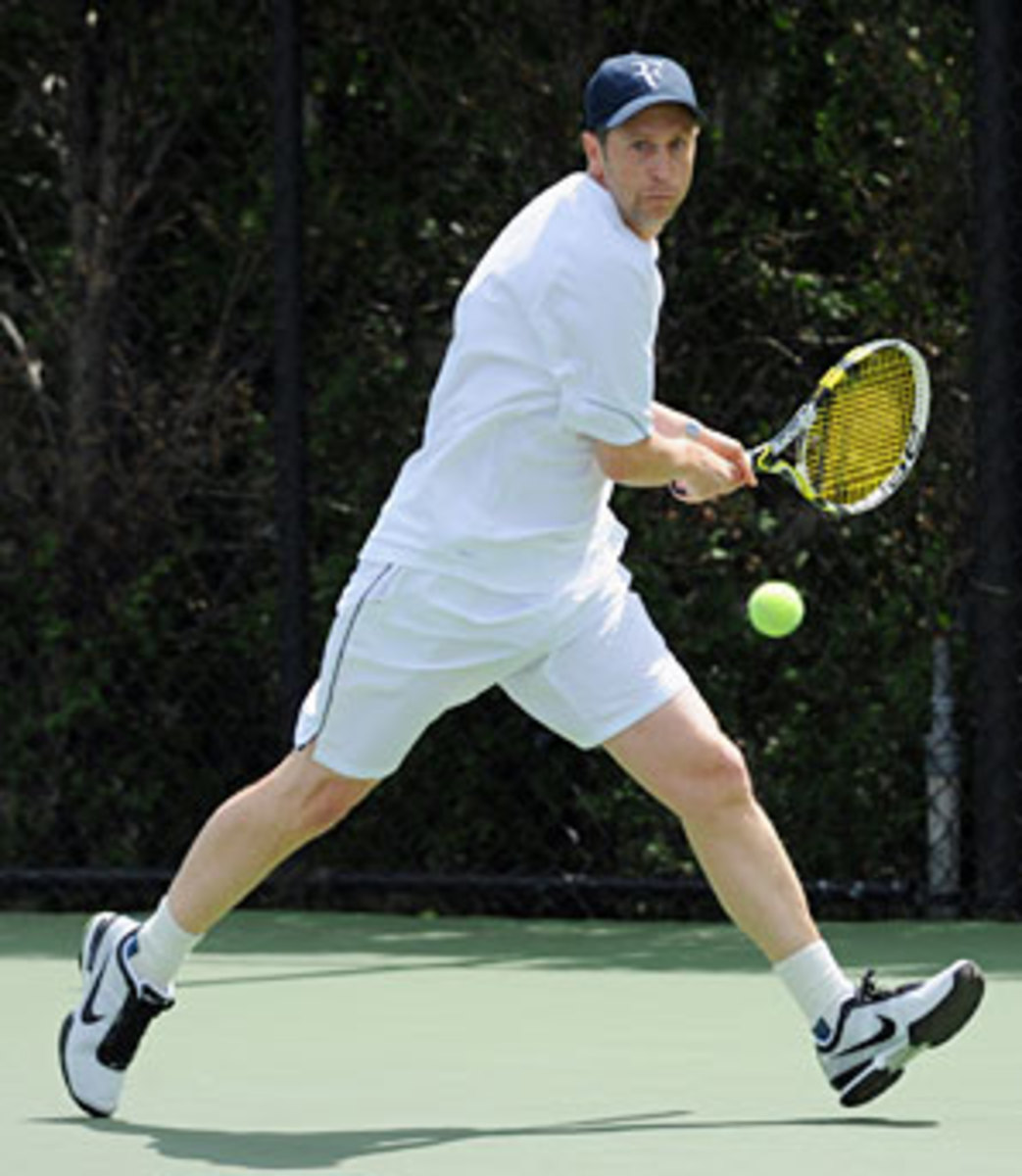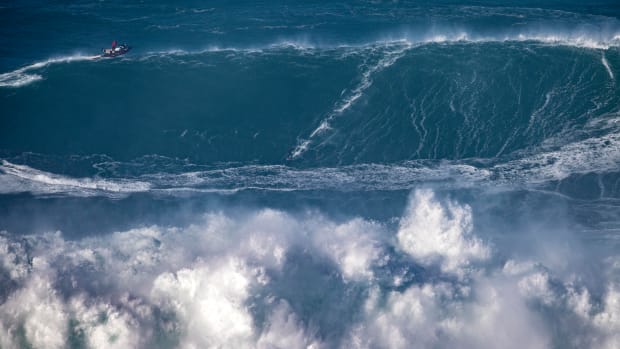USTA's national playoff system opens U.S. Open to masses
NEW YORK -- You may have never heard of Rabbi Gregg Ackerman, but he began Sunday just 21 matches from winning this year's U.S. Open.
For the first time, the United States Tennis Association is giving anyone 14 or older a chance to qualify for a Grand Slam that's become more "open" than ever before. The first of 16 men's and women's sectional qualifying tournaments kicked off Sunday at the Billie Jean King National Tennis Center in Flushing, N.Y. The winners advance to the National Playoffs in July, where the champion will be granted a wild card to the U.S. Open Qualifying Tournament in August. They'll compete for a spot in the 128-player main draw alongside hopeful professionals ranked just outside the Top 100.
That's why Ackerman, 40, made the short drive from Long Island early Sunday morning: for a chance to play for a chance to play for a chance to play in one of the world's oldest and most prestigious sporting events.
Ackerman, who grew up in the Bronx but lives in Cedarhurst, took up tennis at 7 and played for Lehman College. He's taught the sport over the years at Cunningham Park in Queens -- when he's not leading the Jewish programs at the Woodmere Rehabilitation and Health Care Center -- but the observant Jew is unable to play competitively since most age-group tournaments occur on Saturdays.
When Ackerman learned the USTA's new playoff venture presented no immediate conflict with the Sabbath, ponying up the $125 entry fee was a no-brainer.
"It's always been a big dream of mine to compete on this level and on this stage," Ackerman said. "As they say, you've got to dream big."
The U.S. Open calls itself the world's best-attended sporting event, with a record 721,059 fans paying their way onto the grounds in 2009. The kickoff Sunday brought out just a couple hundred players, family members and tournament officials. The scene was quiet, save for the faint hum of music from Flushing Meadows Corona Park and the occasional LaGuardia-bound plane in descent. But just because the turnout couldn't recreate traditional U.S. Open atmosphere, the play was no less intense, the emotions no less authentic. Most came from the Northeast -- with 40 entrants from Long Island alone -- but several trekked from destinations as scattered as Virginia, Ohio, Georgia and Florida. High-level juniors played against seniors, seven-day-a-week savants went against weekend warriors, and moonlighters mixed with moonballers on the outer courts in the shadow of Arthur Ashe Stadium.
The romantic underpinnings of the concept have attracted several notables to the fray. Olympic gold medalist Bode Miller, who comes from a tennis family in Maine and won the state singles title as a high school senior, is playing the Hawaii Pacific sectional at Central Oahu Regional Park beginning June 1. Jeff Tarango, a 41-year-old former pro who retired from the ATP Tour in 2003, believes the Northern California event is his best opportunity to return to Flushing Meadow for the first time since 2000.
Some of the familiar names at Sunday's Eastern Sectional included Tennis magazine writer Tom Perrotta, sparked by curiosity and the opportunity for some Plimptonian participatory journalism, who advanced to the Round of 64 on a bye and a withdrawal. Gordon Smith, the executive director and CEO of the USTA (and a former Division I player), played the first match of the tournament opposite Michael McCasland, a 27-year-old Brooklynite who was just thrilled to get some face time with the USTA exec to attract institutional support for his nascent community tennis program at the Marcy Playground projects.
None of the players were seeded, and the random nature of a blind draw resulted in some intriguing matchups. Local juniors Max Haskin and Thomas Klosinski are high school seniors bound for Cornell and Columbia, respectively, and were surprised to see they were paired against one another. The future Ivy League rivals have played each other many times over the years, but Klosinski prevailed 6-4, 6-4 in Sunday's first-rounder.
The match of the day was a showdown between the oldest player in the men's draw and one of the youngest -- think The Rookie meets Rookie of the Year. Richie Bustamante, a 61-year-old contractor who refurbishes tennis courts for a living (and whose grandfather was a former Davis Cup competitor for Peru), rallied for the first set after a tentative start against 15-year-old Sebastien Lafontant and had a pair of match points in the second. But the Bronx teenager, who trains at the National Tennis Center, dug deep to take the set and survived 6-1, 4-6, 7-6(5) after a third-set tiebreaker.
The players came from a wide variety of backgrounds and experience levels. Charles An, a 38-year-old architect from Manhattan and confessed "crazy obsessed" tennis junkie, came to "catch some good matches" and was thrilled by an idea "in the spirit of the Open." Nikola Hubernova, 30, is a former USTA Pro Circuit player with a career-high ranking of No. 316 with hopes of making her first-ever U.S. Open. David Spellman, a 43-year-old Melville, N.Y., native, suffers from Chron's disease and hopes to spread awareness of the condition by competing in the playoffs. Thomas Nordstrom, a 59-year-old from Bridgewater, N.J., who became an orthopedic surgeon after playing collegiately at Hobart, was looking for local age-group tournaments online when he discovered the opportunity to qualify for the Grand Slam he's attended for years as a fan.
Nordstrom, who stayed at a Marriott by LaGuardia airport due to his 8 a.m. start time, lost to talented 15-year-old junior Harrison Digia -- "I was afraid of this: running into a buzzsaw," Nordstrom confessed -- but couldn't have been more upbeat about the experience.
"This is a bucket list thing: See the Pope, go the Olympics, play at the U.S. Open," Nordstrom continued. "It's a fantasy."
The most vocal crowd support was reserved for Ackerman, who stepped on Court 8 around noon behind two dozen friends and family members toting handmade posters and mylar balloons. His opponent was 15-year-old Vikram Ravoory, a wiry high school sophomore from Connecticut who moved to Orlando three years ago to focus on tennis. Ravoory could have played at the Florida Sectional qualifier at the IMG/Bollettieri Academies -- but the opportunity to play at the home of the U.S. Open was too enticing to pass up.
The raw talent of Ravoory was evident as soon as play began, but Ackerman's cagey serve-and-volley game made for a competitive, back-and-forth match. Clever shotmaking and a paucity of errors helped the rabbi stake a permanent lead in the second set.
When Ackerman capped the 6-4, 6-4 victory with an emphatic winner, his cheering section poured onto the court as a USTA camera crew captured the moment. Chants of "We want Roger!" served notice to a certain five-time U.S. Open champion.
"I did a lot of praying in the morning," Ackerman said. "My final goal is eventually to stand on the court at Arthur Ashe Stadium."
He's no more than 20 matches away.






